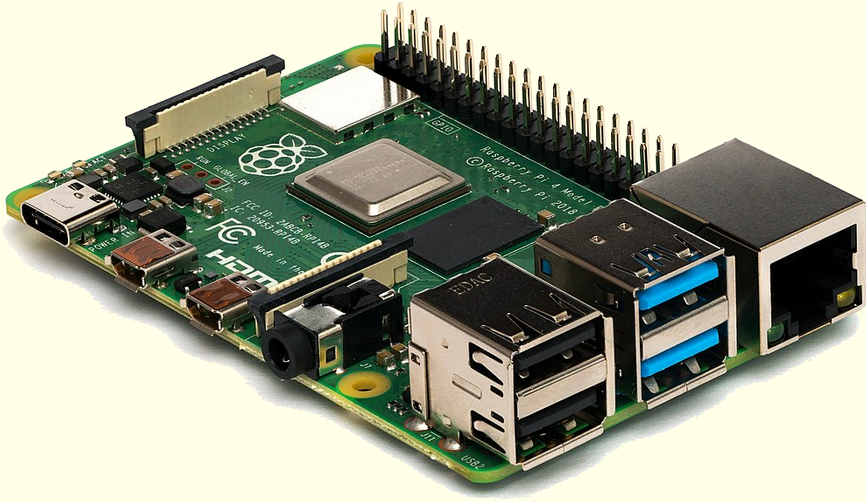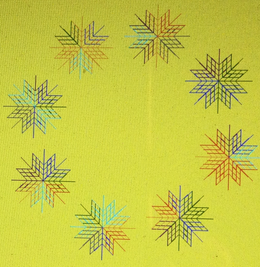|
|
My Raspberry Pi:
Trick or treat? 1
Lakefield, Qué, October 31, 2021
With malice toward none 2
What I am about to write about on my Raspberry Pi single-board computer is certainly not the most important issue on people's minds. Global warming and Covid-19 come way ahead; and how to stay on top in a world doomed to perdition. Nevertheless, digital technology does have a significant place in the scheme of things. As for my topic, the Raspberry Pi owes its existence to the notion that digital technology needs well qualified people to fulfill its role in the modern world. This small computer first saw the light in Febuary 2012, in the United Kingdom, then soon captured worldwide attention by storm. Variants of the Raspberry Pi were developed and newer versions came into existence. 3
 Raspberry Pi Model 400. Dimensions: 3.94 x 2.76 in. ( Source) 4
Intrigued by the pins to the right? They permit computer-controlled experiments with electronic devices ranging from simple light displays to robots. The market is well stocked by books about learning programming and experimenting with elctronics using a Raspberry Pi computer board. Of course, one also needs a power supply, a monitor, and a keyboard. A set of speakers may be welcome as well. 5
What was originally intended to be a cheap educational tool soon found applications in business too. In the process the Raspberry Pi and its offshoots have become not only the subject of many books but also of articles in print and on the Internet, plus Internet videos. Much of what has been published since the Raspberry Pi was born has become outdated which, in turn, brought about serious information pollution getting in the way of learning. 6
* * *
Whatever my own reasons for acquiring a Raspberry were, to me they were good reasons and it didn't take me long to have it up and running the recommended operating system, the Raspberry OS. 7
"It didn't take me long ..." I just wrote. Actually I had some help from a digital tool (some app) named "Imager." Imager lets one pick from a small collection of operating systems which includes that highly recommended Raspberry OS. After having entered a choice, Imager next asks where to store that chosen operating system. It needs to be on some micro system disk, microSD for short, which after Imager has done its part is then to be inserted in a slot on the Raspberry Pi. I went into some detail here because it is important to this story as it unfolds. 8

microSD, actual size. 9
The beauty of having a microSD with an operating system installed on it is that it can be pulled out of its slot and another such chip with another operating system inserted in its place. I now work with two operating systems, the Raspberry OS and a long-time favorite of mine, Xubuntu. The first one serves me best for learning Logo and Python, and the other for much of whatever else I want to do. 9
* * *
Getting Xubuntu didn't come easy. For days and days, all my spare time went into wading through crud referencing to other crud until I finally gave up. In the process I twice returned a Raspberry Pi 400 Personal Computer Kit because of defects (so much for quality control) and then bought, just a few weeks ago, a CanaKit Raspberry Pi 4 8GB. Start-up time is relatively short as far as Rasperry computers go, but long compared to modern laptop computers. The kit included an 8-GB microSD card preloaded with NOOBS which, quoting, "is designed to make it easy to select and install operating systems for the Raspberry Pi without having to worry about manually imaging your MicroSD card." 11
That word, NOOBS, came up often in all that crud I had been wading through. Obviously, so it seemed to me, it is important to get acquainted with NOOBS. I hit upon an article, dated 2013, whch informed me where I can download NOOBS, but I got something else instead. I immediately wrote the author, "Par. 2 of your article says that you can download NOOBS here But NOT so." A reply came fast: "We no longer recommend the use of NOOBS - either download the Raspberry Pi imager or an operating system image from https://www.rasperrypi.com/software." Why the heck then was that obsolete article still on the Internet? What the heck was that microSD card doing in my kit from CanaKit? Just other pieces of crud wasting my time by confusing me. Wasn't the original Raspberry computer meant to promote learning about digital technology? 12
Let me get back to Xubuntu. Luck had it that I landed on a website that told me how to istall Xubuntu on a Raspberry Pi computer. Here, if you like to know:
https://www.addictivetips.com/ubuntu-linux-tips/xubuntu-raspberry-pi-4/
I did run into a warning along the way of installing it, "System problem detected," and indeed I found that some softwares froze my favorite OS and needed to be restarted. But one day, maybe, my prince will come.
Que sera, sera
Whatever will be, will be
The future's not ours to see
Dum spiro spero
As long as I breathe, I hope. 13
To end this story on a positive note, I already got a lot of joy out of that Raspberry OS. It brought me back to doing some turtle geometry which in a distant past I knew as Seymour Papert's Logo. It also set me on the road to learning programming in Python. With a modicum of fiddling around, I got well on my way with these two books: "Turtle Geometry," by Harold Abelson and Andrea diSessa, and "Python Crash Course," by Eric Matthes. I'll quote a few lines from the first book:
"You are probably familiar with the uses of coordinates in geometry: studying geometric figures via equations, plotting graphs of numerical relationsships, and so on. Indeed, Descartes' marriage of algebra and geometry is one of the fundamental insights in the development of mathematics. Nevertheless, these kind of coordinate systems—Cartesian, polar, or what have you—are not the only way to relate numbers to geometry. The turtle FORWARD and RIGHT commands give an alternative way of measuring figures in the plane, a way that complemens the coordinate viewpoint."
And not only on plane surfaces, but also on curved surfaces. The book's final chapters deal with curved space and general relativity. Ought to be fascinating. 14
 A sill picture of one of my efforts 15The second book was written primarily for high-school students. It is broaly divided into two parts, one part about he basics of programming in Python, the other offering projects to engage in. 16
So, what about my beloved Xubuntu? I happen to have a nice, clean version on an about 12-year-old Acer computer, a version I can from time to time update dum spiro. 17
|

![]()
![]()